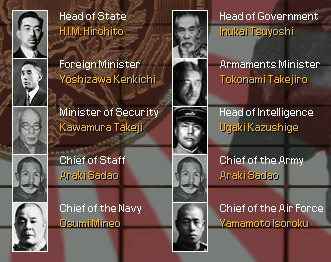Japan
From Kaiserreich
| ||||
| Anthem Kimi ga yo | ||||
| Official Language | Japanese | |||
| Capital | Tokyo | |||
| Emperor | Hirohito(era name: Showa) | |||
| Prime Minister | Inukai Tsuyoshi | |||
| Establishment - Meiji Restoration | January 3, 1868 | |||
| Government | Constitutional monarchy | |||
| Currency | Yen | |||
| Area | 675,000 km² | |||
| Population | circa 97,770,000 | |||
Japan is a state in East Asia. It consists of numerous island and the Korean peninsula. To the north it borders Transamur and to the west it borders the Fengtien Republic
Contents |
History
While the 'Peace with Honor' guaranteed Japan's rule of her overseas territories, most importantly Korea, the situation in Japan was already critical well before the end of Weltkrieg. Japan's once booming economy had turned to ashes immediately after the collapse of France and the gap between social classes continued to widen. Starting with the Rice Riot of 1918, the later period of the Taisho Era (1912-1926) witnessed severe economic crises and social conflict. Also one of the greatest natural disasters in human history happened, the Great Kanto Earthquake of 1923, which was then followed by an anarchist rebellion influenced by France's syndicalist revolution. After a failed attempt on Regent Hirohito's life by a lone anarchist, martial law was declared for the first time in Japanese history. General Tanaka Giichi (1864-1936) formed a cabinet with support from the Genro and Seiyuhonto (splinter groups of the Seiyukai), and then introduced the Peace Preservation Law which symbolized the Draconian rule of Tanaka. However, with collapse of the British Empire and with the economic depression in America, Japan's export-led economy continued free fall with no end in sight. 1926 saw a series of massive bank closures at home and German military intervention in China. As Tanaka was incapable to protect Japan's interest in China or stabilise financial system, the weakness of his rule was exposed. By April of that year, the two main opposition parties, Seiyukai and Kenseikai, formed a coalition and and started so-called 'the 2nd Movement to Protect the Constitution'. With popular support for the opposition and Prince Regent's indirect intervention, Tanaka was forced to resign. The coalition cabinet was formed, marking the beginning of democratic governance, universal suffrage and party-based cabinet. The coalition however, collapsed over the issue of intervention in Manchuria. Prime minister Inukai Tsuyoshi, and his Seiyukai cabinet, was determined to support Zhang Zuelin, the Warlord of Manchuria in an attempt to alleviate or resolve a number of economic difficulties, and prevent a complete German domination of China. On June 4 Japanese troops crossed the Manchurian border and quickly occupied all of Manchuria. Further advances were halted however due to diplomatic pressure emanating from Berlin. Nevertheless the success of the campaign helped to solidify the strong position of the military, most of whom felt the way forwards was to seek further conquests elsewhere. The chaotic year of 1926 ended with the death of Emperor Taisho and his son Hirohito assumed the throne. The next nine years saw mild economic recovery and peaceful political developments. Japan in 1936 is poised to extend her empire, with Germany's dominance of the world appearing to be in decline the Japanese look greedily at both the remaining Qing Chinese territories and the German pacific possessions.
Politics
|
Emperor: His Imperial Majesty the Emperor Hirohito (born 29 April 1901)
Prime Minister: Inukai Tsuyoshi (Rikken Seiyukai, born 20 April 1855)
Minister for Foreign Affairs: Yoshizawa Kenkichi (born 24 January 1874)
Minister of Finance: [[Takejir�� Tokonami]] (born in 1865)
Minister for Home Affairs: Kawamura Takeji (born 17 July 1871)
Secret Services Supreme Commander: General Ugaki Kazushige (born 9 August 1868)
Chief of the Imperial Army General Staff: General Araki Sadao (born 26 May 1877)
Chief of the Imperial Navy General Staff: Admiral Ōsumi Mineo (born 1 May 1876)
Chief of the Imperial Air Force General Staff: Admiral Yamamoto Isoroku (born 4 April 1884)
Military
Japan is the foremost military powerhouse in Asia. Possessing the third largest navy in the world and a considerably large army with modern equipment, tactics and industrial capacity to supply it. Japan is a force to be reckoned with in any conflict taking place in the Far-East. Still, the armed forces of Japan face several problems. The relative lack of resources in the Japanese home islands places severe restrictions on the capability of Japan to wage a long-term war and the supply convoys of the Pacific are vulnerable to naval attacks.
Army
The majority of the standing army of Japan is currently stationed in the Fengtien Republic, Transamur and Korea. A significant number of garrisons are also situated in the Japanese-held islands in the Pacific Ocean, like Wake and Iwo Jima.
Navy
The Nihon Kaigun is one of the few navies in the world that employ aircraft carriers and thus it has significant power-projection capabilites and most major ports in the Pacific are within its reach. Being one of the largest navies of the world, the Nihon Kaigun has a vast array of vessels, from the aforementioned aircraft carriers to battleships and cruisers of various sizes. One of the most important tasks of the navy is to protect the vital trade and supply routes of the Pacific and a vast number of destroyers are deployed for this task.
Air Force
The Air Force is mainly tasked with supporting the two other military branches and thus employs a significant amount of tactical and naval bombers, the latter which are also used for convoy protection.
Foreign relations
Military and economic alliance with Transamur. Japan has political and economic control over Transamur and Fengtien Republic.
Very good relations with Fengtien Republic and Transamur.
Friendly relations with Mongolia and Canada.
Unfriendly relations with Germany and Qing Empire.
Culture
WIP



